Information Technology for Competitive Advantage: A Citibank Report
VerifiedAdded on 2023/06/15
|13
|4145
|74
Report
AI Summary
This report provides an overview of information technology's role within businesses, particularly focusing on Citibank. It begins by defining the use of IT in enhancing organizational efficiency and maintaining a competitive edge. The report then delves into specific application software types used in the banking sector, such as investment banking, SMS banking, accounting software, and mobile banking, highlighting their benefits. Ethical and social issues, including climate change, employee safety, and data security, are identified and analyzed. The report differentiates between various networking technologies like edge computing, software-defined networking, LAN, multi-cloud networking, and serverless computing. The impact of artificial intelligence on business operations is discussed, alongside the stages of the software development life cycle. The report concludes by emphasizing the importance of IT in modern business operations. Desklib provides access to this and other solved assignments for students.
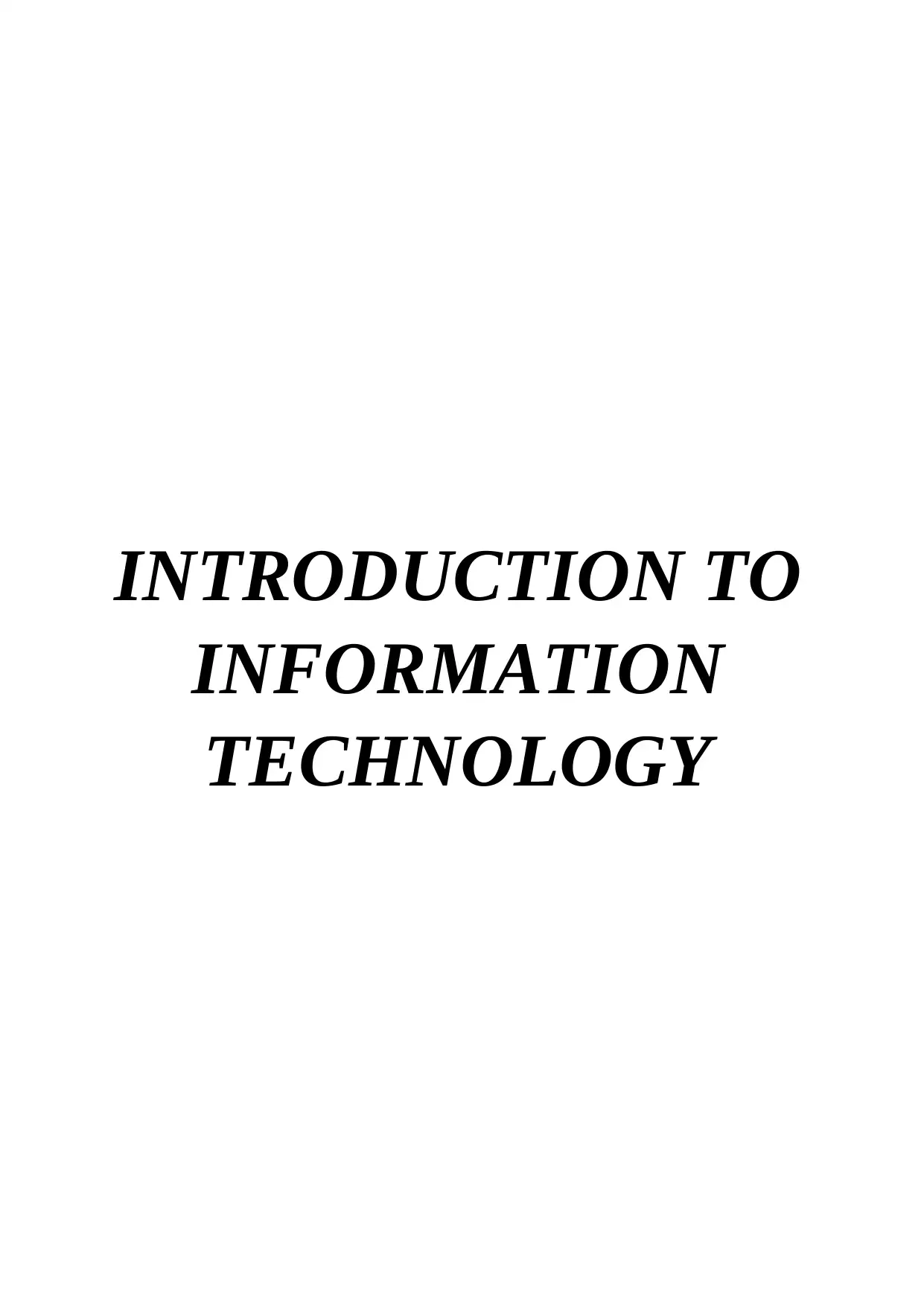
INTRODUCTION TO
INFORMATION
TECHNOLOGY
INFORMATION
TECHNOLOGY
Paraphrase This Document
Need a fresh take? Get an instant paraphrase of this document with our AI Paraphraser
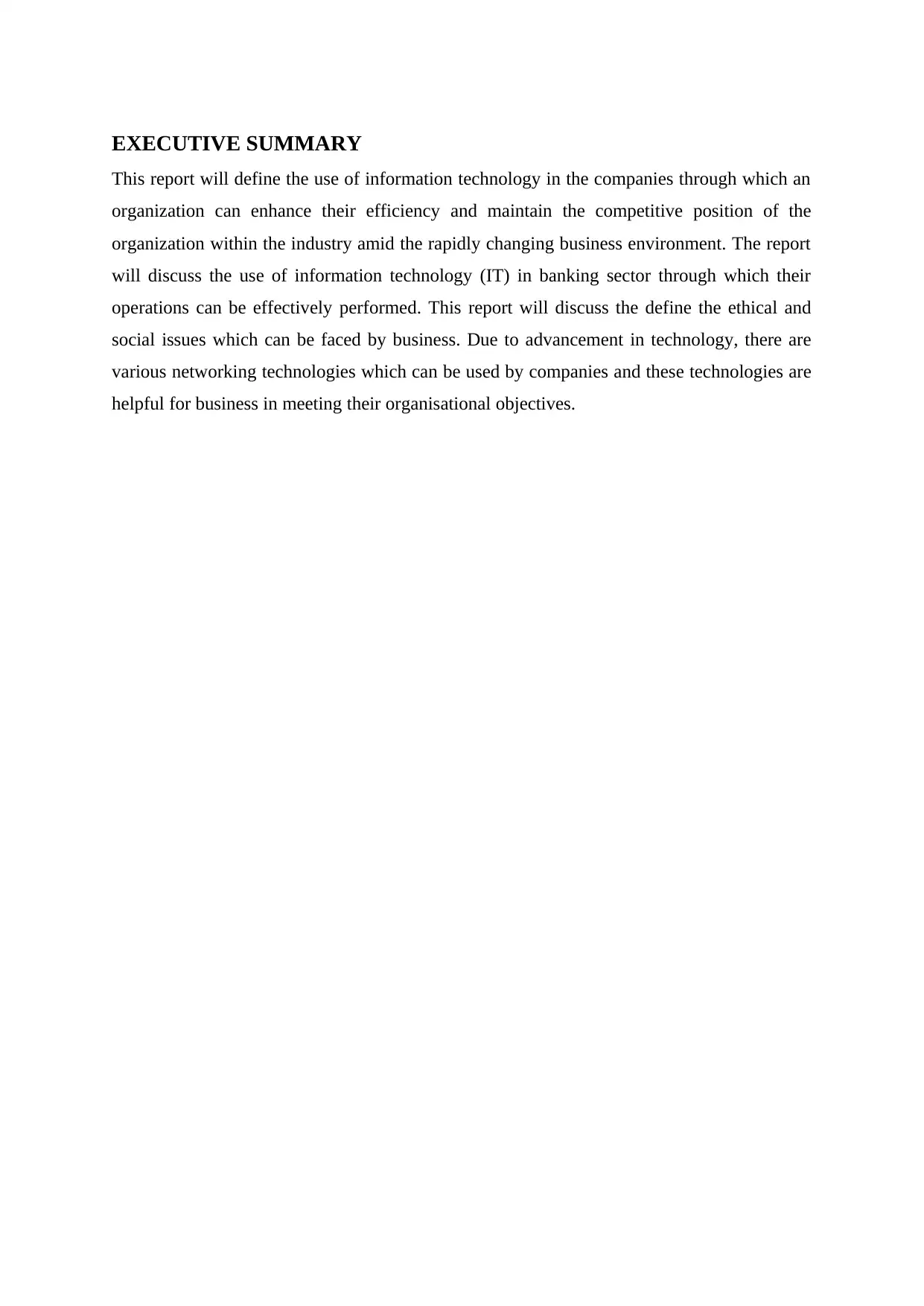
EXECUTIVE SUMMARY
This report will define the use of information technology in the companies through which an
organization can enhance their efficiency and maintain the competitive position of the
organization within the industry amid the rapidly changing business environment. The report
will discuss the use of information technology (IT) in banking sector through which their
operations can be effectively performed. This report will discuss the define the ethical and
social issues which can be faced by business. Due to advancement in technology, there are
various networking technologies which can be used by companies and these technologies are
helpful for business in meeting their organisational objectives.
This report will define the use of information technology in the companies through which an
organization can enhance their efficiency and maintain the competitive position of the
organization within the industry amid the rapidly changing business environment. The report
will discuss the use of information technology (IT) in banking sector through which their
operations can be effectively performed. This report will discuss the define the ethical and
social issues which can be faced by business. Due to advancement in technology, there are
various networking technologies which can be used by companies and these technologies are
helpful for business in meeting their organisational objectives.
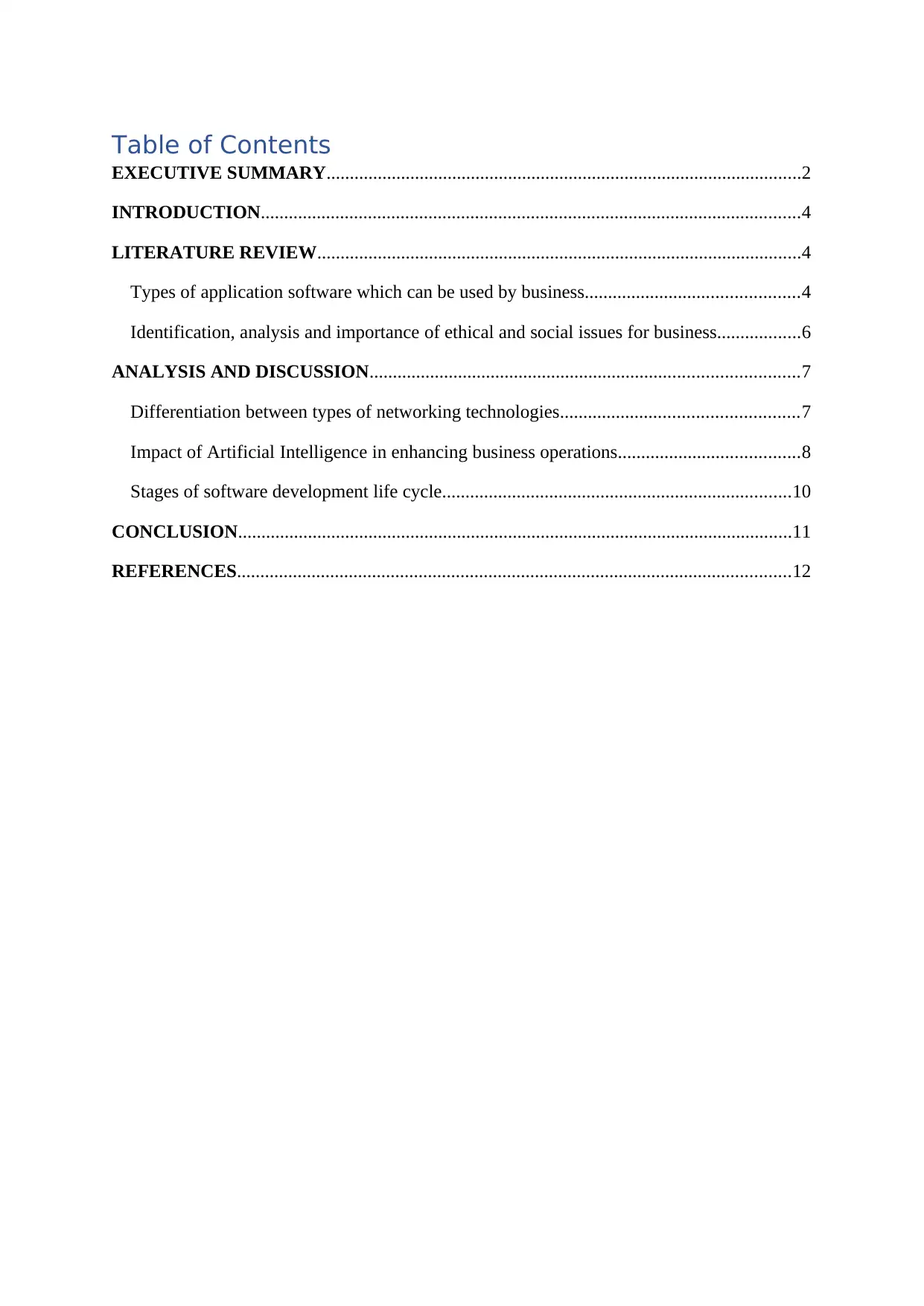
Table of Contents
EXECUTIVE SUMMARY......................................................................................................2
INTRODUCTION....................................................................................................................4
LITERATURE REVIEW........................................................................................................4
Types of application software which can be used by business..............................................4
Identification, analysis and importance of ethical and social issues for business..................6
ANALYSIS AND DISCUSSION............................................................................................7
Differentiation between types of networking technologies...................................................7
Impact of Artificial Intelligence in enhancing business operations.......................................8
Stages of software development life cycle...........................................................................10
CONCLUSION.......................................................................................................................11
REFERENCES.......................................................................................................................12
EXECUTIVE SUMMARY......................................................................................................2
INTRODUCTION....................................................................................................................4
LITERATURE REVIEW........................................................................................................4
Types of application software which can be used by business..............................................4
Identification, analysis and importance of ethical and social issues for business..................6
ANALYSIS AND DISCUSSION............................................................................................7
Differentiation between types of networking technologies...................................................7
Impact of Artificial Intelligence in enhancing business operations.......................................8
Stages of software development life cycle...........................................................................10
CONCLUSION.......................................................................................................................11
REFERENCES.......................................................................................................................12
⊘ This is a preview!⊘
Do you want full access?
Subscribe today to unlock all pages.

Trusted by 1+ million students worldwide
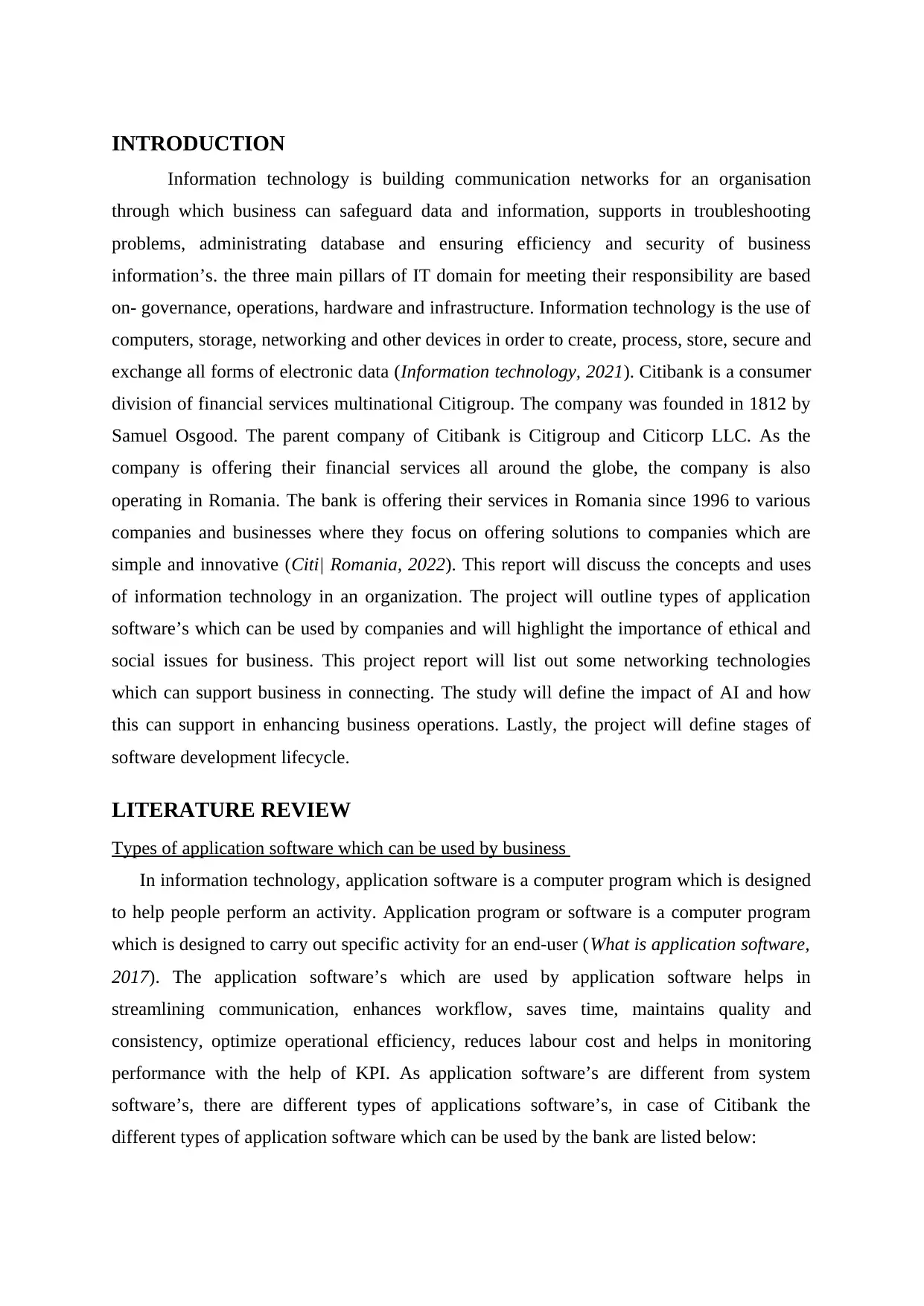
INTRODUCTION
Information technology is building communication networks for an organisation
through which business can safeguard data and information, supports in troubleshooting
problems, administrating database and ensuring efficiency and security of business
information’s. the three main pillars of IT domain for meeting their responsibility are based
on- governance, operations, hardware and infrastructure. Information technology is the use of
computers, storage, networking and other devices in order to create, process, store, secure and
exchange all forms of electronic data (Information technology, 2021). Citibank is a consumer
division of financial services multinational Citigroup. The company was founded in 1812 by
Samuel Osgood. The parent company of Citibank is Citigroup and Citicorp LLC. As the
company is offering their financial services all around the globe, the company is also
operating in Romania. The bank is offering their services in Romania since 1996 to various
companies and businesses where they focus on offering solutions to companies which are
simple and innovative (Citi| Romania, 2022). This report will discuss the concepts and uses
of information technology in an organization. The project will outline types of application
software’s which can be used by companies and will highlight the importance of ethical and
social issues for business. This project report will list out some networking technologies
which can support business in connecting. The study will define the impact of AI and how
this can support in enhancing business operations. Lastly, the project will define stages of
software development lifecycle.
LITERATURE REVIEW
Types of application software which can be used by business
In information technology, application software is a computer program which is designed
to help people perform an activity. Application program or software is a computer program
which is designed to carry out specific activity for an end-user (What is application software,
2017). The application software’s which are used by application software helps in
streamlining communication, enhances workflow, saves time, maintains quality and
consistency, optimize operational efficiency, reduces labour cost and helps in monitoring
performance with the help of KPI. As application software’s are different from system
software’s, there are different types of applications software’s, in case of Citibank the
different types of application software which can be used by the bank are listed below:
Information technology is building communication networks for an organisation
through which business can safeguard data and information, supports in troubleshooting
problems, administrating database and ensuring efficiency and security of business
information’s. the three main pillars of IT domain for meeting their responsibility are based
on- governance, operations, hardware and infrastructure. Information technology is the use of
computers, storage, networking and other devices in order to create, process, store, secure and
exchange all forms of electronic data (Information technology, 2021). Citibank is a consumer
division of financial services multinational Citigroup. The company was founded in 1812 by
Samuel Osgood. The parent company of Citibank is Citigroup and Citicorp LLC. As the
company is offering their financial services all around the globe, the company is also
operating in Romania. The bank is offering their services in Romania since 1996 to various
companies and businesses where they focus on offering solutions to companies which are
simple and innovative (Citi| Romania, 2022). This report will discuss the concepts and uses
of information technology in an organization. The project will outline types of application
software’s which can be used by companies and will highlight the importance of ethical and
social issues for business. This project report will list out some networking technologies
which can support business in connecting. The study will define the impact of AI and how
this can support in enhancing business operations. Lastly, the project will define stages of
software development lifecycle.
LITERATURE REVIEW
Types of application software which can be used by business
In information technology, application software is a computer program which is designed
to help people perform an activity. Application program or software is a computer program
which is designed to carry out specific activity for an end-user (What is application software,
2017). The application software’s which are used by application software helps in
streamlining communication, enhances workflow, saves time, maintains quality and
consistency, optimize operational efficiency, reduces labour cost and helps in monitoring
performance with the help of KPI. As application software’s are different from system
software’s, there are different types of applications software’s, in case of Citibank the
different types of application software which can be used by the bank are listed below:
Paraphrase This Document
Need a fresh take? Get an instant paraphrase of this document with our AI Paraphraser
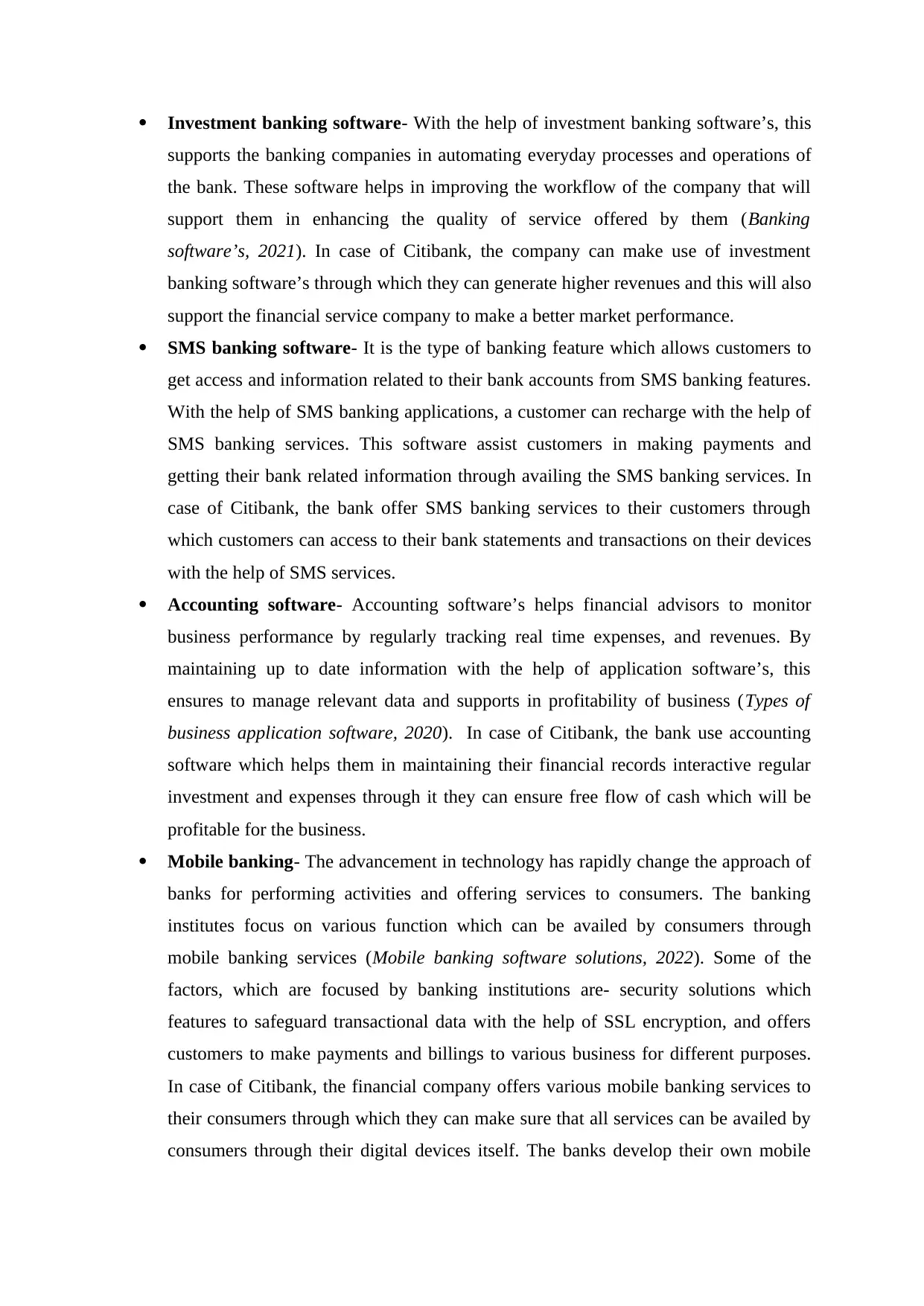
Investment banking software- With the help of investment banking software’s, this
supports the banking companies in automating everyday processes and operations of
the bank. These software helps in improving the workflow of the company that will
support them in enhancing the quality of service offered by them (Banking
software’s, 2021). In case of Citibank, the company can make use of investment
banking software’s through which they can generate higher revenues and this will also
support the financial service company to make a better market performance.
SMS banking software- It is the type of banking feature which allows customers to
get access and information related to their bank accounts from SMS banking features.
With the help of SMS banking applications, a customer can recharge with the help of
SMS banking services. This software assist customers in making payments and
getting their bank related information through availing the SMS banking services. In
case of Citibank, the bank offer SMS banking services to their customers through
which customers can access to their bank statements and transactions on their devices
with the help of SMS services.
Accounting software- Accounting software’s helps financial advisors to monitor
business performance by regularly tracking real time expenses, and revenues. By
maintaining up to date information with the help of application software’s, this
ensures to manage relevant data and supports in profitability of business (Types of
business application software, 2020). In case of Citibank, the bank use accounting
software which helps them in maintaining their financial records interactive regular
investment and expenses through it they can ensure free flow of cash which will be
profitable for the business.
Mobile banking- The advancement in technology has rapidly change the approach of
banks for performing activities and offering services to consumers. The banking
institutes focus on various function which can be availed by consumers through
mobile banking services (Mobile banking software solutions, 2022). Some of the
factors, which are focused by banking institutions are- security solutions which
features to safeguard transactional data with the help of SSL encryption, and offers
customers to make payments and billings to various business for different purposes.
In case of Citibank, the financial company offers various mobile banking services to
their consumers through which they can make sure that all services can be availed by
consumers through their digital devices itself. The banks develop their own mobile
supports the banking companies in automating everyday processes and operations of
the bank. These software helps in improving the workflow of the company that will
support them in enhancing the quality of service offered by them (Banking
software’s, 2021). In case of Citibank, the company can make use of investment
banking software’s through which they can generate higher revenues and this will also
support the financial service company to make a better market performance.
SMS banking software- It is the type of banking feature which allows customers to
get access and information related to their bank accounts from SMS banking features.
With the help of SMS banking applications, a customer can recharge with the help of
SMS banking services. This software assist customers in making payments and
getting their bank related information through availing the SMS banking services. In
case of Citibank, the bank offer SMS banking services to their customers through
which customers can access to their bank statements and transactions on their devices
with the help of SMS services.
Accounting software- Accounting software’s helps financial advisors to monitor
business performance by regularly tracking real time expenses, and revenues. By
maintaining up to date information with the help of application software’s, this
ensures to manage relevant data and supports in profitability of business (Types of
business application software, 2020). In case of Citibank, the bank use accounting
software which helps them in maintaining their financial records interactive regular
investment and expenses through it they can ensure free flow of cash which will be
profitable for the business.
Mobile banking- The advancement in technology has rapidly change the approach of
banks for performing activities and offering services to consumers. The banking
institutes focus on various function which can be availed by consumers through
mobile banking services (Mobile banking software solutions, 2022). Some of the
factors, which are focused by banking institutions are- security solutions which
features to safeguard transactional data with the help of SSL encryption, and offers
customers to make payments and billings to various business for different purposes.
In case of Citibank, the financial company offers various mobile banking services to
their consumers through which they can make sure that all services can be availed by
consumers through their digital devices itself. The banks develop their own mobile
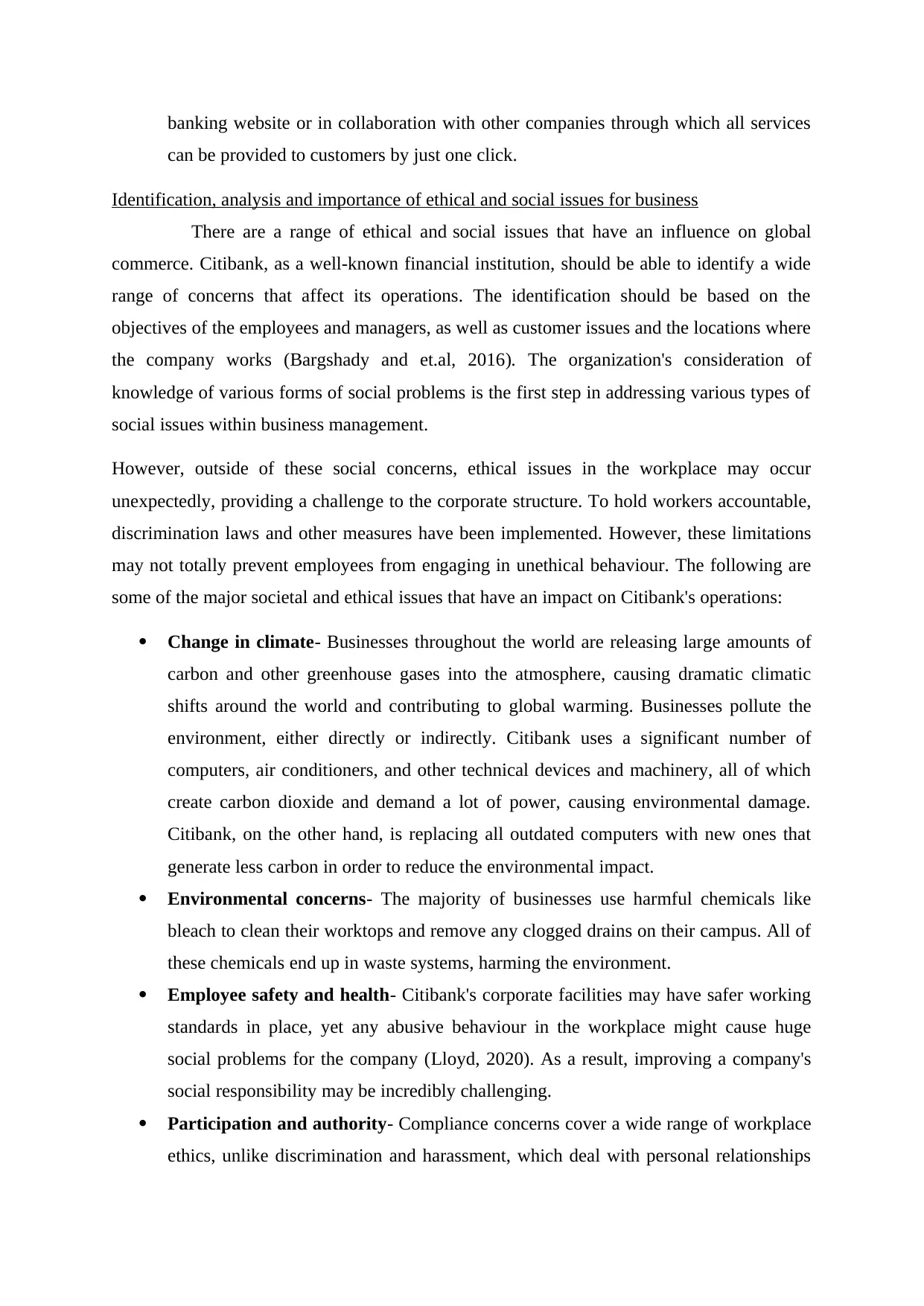
banking website or in collaboration with other companies through which all services
can be provided to customers by just one click.
Identification, analysis and importance of ethical and social issues for business
There are a range of ethical and social issues that have an influence on global
commerce. Citibank, as a well-known financial institution, should be able to identify a wide
range of concerns that affect its operations. The identification should be based on the
objectives of the employees and managers, as well as customer issues and the locations where
the company works (Bargshady and et.al, 2016). The organization's consideration of
knowledge of various forms of social problems is the first step in addressing various types of
social issues within business management.
However, outside of these social concerns, ethical issues in the workplace may occur
unexpectedly, providing a challenge to the corporate structure. To hold workers accountable,
discrimination laws and other measures have been implemented. However, these limitations
may not totally prevent employees from engaging in unethical behaviour. The following are
some of the major societal and ethical issues that have an impact on Citibank's operations:
Change in climate- Businesses throughout the world are releasing large amounts of
carbon and other greenhouse gases into the atmosphere, causing dramatic climatic
shifts around the world and contributing to global warming. Businesses pollute the
environment, either directly or indirectly. Citibank uses a significant number of
computers, air conditioners, and other technical devices and machinery, all of which
create carbon dioxide and demand a lot of power, causing environmental damage.
Citibank, on the other hand, is replacing all outdated computers with new ones that
generate less carbon in order to reduce the environmental impact.
Environmental concerns- The majority of businesses use harmful chemicals like
bleach to clean their worktops and remove any clogged drains on their campus. All of
these chemicals end up in waste systems, harming the environment.
Employee safety and health- Citibank's corporate facilities may have safer working
standards in place, yet any abusive behaviour in the workplace might cause huge
social problems for the company (Lloyd, 2020). As a result, improving a company's
social responsibility may be incredibly challenging.
Participation and authority- Compliance concerns cover a wide range of workplace
ethics, unlike discrimination and harassment, which deal with personal relationships
can be provided to customers by just one click.
Identification, analysis and importance of ethical and social issues for business
There are a range of ethical and social issues that have an influence on global
commerce. Citibank, as a well-known financial institution, should be able to identify a wide
range of concerns that affect its operations. The identification should be based on the
objectives of the employees and managers, as well as customer issues and the locations where
the company works (Bargshady and et.al, 2016). The organization's consideration of
knowledge of various forms of social problems is the first step in addressing various types of
social issues within business management.
However, outside of these social concerns, ethical issues in the workplace may occur
unexpectedly, providing a challenge to the corporate structure. To hold workers accountable,
discrimination laws and other measures have been implemented. However, these limitations
may not totally prevent employees from engaging in unethical behaviour. The following are
some of the major societal and ethical issues that have an impact on Citibank's operations:
Change in climate- Businesses throughout the world are releasing large amounts of
carbon and other greenhouse gases into the atmosphere, causing dramatic climatic
shifts around the world and contributing to global warming. Businesses pollute the
environment, either directly or indirectly. Citibank uses a significant number of
computers, air conditioners, and other technical devices and machinery, all of which
create carbon dioxide and demand a lot of power, causing environmental damage.
Citibank, on the other hand, is replacing all outdated computers with new ones that
generate less carbon in order to reduce the environmental impact.
Environmental concerns- The majority of businesses use harmful chemicals like
bleach to clean their worktops and remove any clogged drains on their campus. All of
these chemicals end up in waste systems, harming the environment.
Employee safety and health- Citibank's corporate facilities may have safer working
standards in place, yet any abusive behaviour in the workplace might cause huge
social problems for the company (Lloyd, 2020). As a result, improving a company's
social responsibility may be incredibly challenging.
Participation and authority- Compliance concerns cover a wide range of workplace
ethics, unlike discrimination and harassment, which deal with personal relationships
⊘ This is a preview!⊘
Do you want full access?
Subscribe today to unlock all pages.

Trusted by 1+ million students worldwide
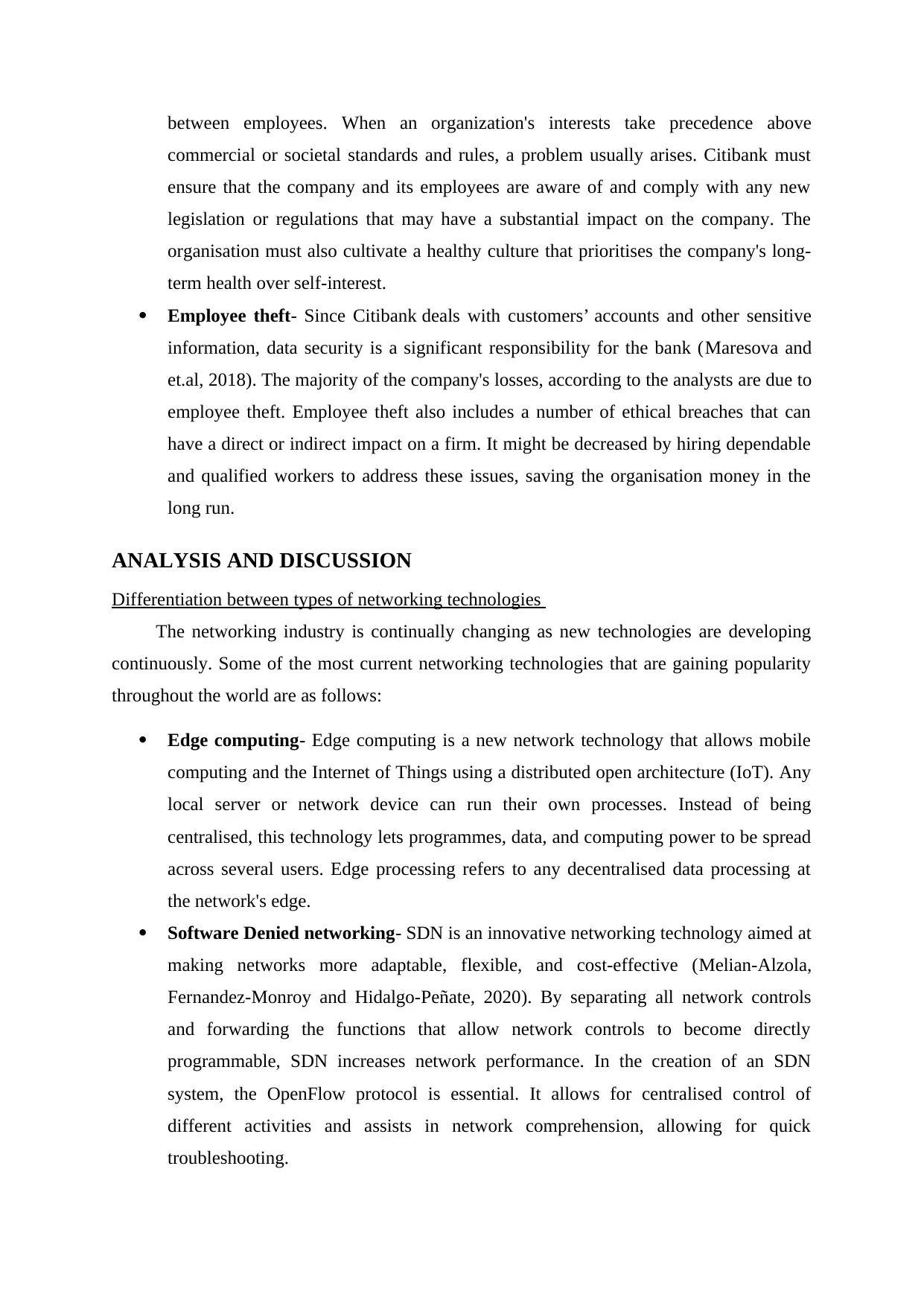
between employees. When an organization's interests take precedence above
commercial or societal standards and rules, a problem usually arises. Citibank must
ensure that the company and its employees are aware of and comply with any new
legislation or regulations that may have a substantial impact on the company. The
organisation must also cultivate a healthy culture that prioritises the company's long-
term health over self-interest.
Employee theft- Since Citibank deals with customers’ accounts and other sensitive
information, data security is a significant responsibility for the bank (Maresova and
et.al, 2018). The majority of the company's losses, according to the analysts are due to
employee theft. Employee theft also includes a number of ethical breaches that can
have a direct or indirect impact on a firm. It might be decreased by hiring dependable
and qualified workers to address these issues, saving the organisation money in the
long run.
ANALYSIS AND DISCUSSION
Differentiation between types of networking technologies
The networking industry is continually changing as new technologies are developing
continuously. Some of the most current networking technologies that are gaining popularity
throughout the world are as follows:
Edge computing- Edge computing is a new network technology that allows mobile
computing and the Internet of Things using a distributed open architecture (IoT). Any
local server or network device can run their own processes. Instead of being
centralised, this technology lets programmes, data, and computing power to be spread
across several users. Edge processing refers to any decentralised data processing at
the network's edge.
Software Denied networking- SDN is an innovative networking technology aimed at
making networks more adaptable, flexible, and cost-effective (Melian-Alzola,
Fernandez-Monroy and Hidalgo-Peñate, 2020). By separating all network controls
and forwarding the functions that allow network controls to become directly
programmable, SDN increases network performance. In the creation of an SDN
system, the OpenFlow protocol is essential. It allows for centralised control of
different activities and assists in network comprehension, allowing for quick
troubleshooting.
commercial or societal standards and rules, a problem usually arises. Citibank must
ensure that the company and its employees are aware of and comply with any new
legislation or regulations that may have a substantial impact on the company. The
organisation must also cultivate a healthy culture that prioritises the company's long-
term health over self-interest.
Employee theft- Since Citibank deals with customers’ accounts and other sensitive
information, data security is a significant responsibility for the bank (Maresova and
et.al, 2018). The majority of the company's losses, according to the analysts are due to
employee theft. Employee theft also includes a number of ethical breaches that can
have a direct or indirect impact on a firm. It might be decreased by hiring dependable
and qualified workers to address these issues, saving the organisation money in the
long run.
ANALYSIS AND DISCUSSION
Differentiation between types of networking technologies
The networking industry is continually changing as new technologies are developing
continuously. Some of the most current networking technologies that are gaining popularity
throughout the world are as follows:
Edge computing- Edge computing is a new network technology that allows mobile
computing and the Internet of Things using a distributed open architecture (IoT). Any
local server or network device can run their own processes. Instead of being
centralised, this technology lets programmes, data, and computing power to be spread
across several users. Edge processing refers to any decentralised data processing at
the network's edge.
Software Denied networking- SDN is an innovative networking technology aimed at
making networks more adaptable, flexible, and cost-effective (Melian-Alzola,
Fernandez-Monroy and Hidalgo-Peñate, 2020). By separating all network controls
and forwarding the functions that allow network controls to become directly
programmable, SDN increases network performance. In the creation of an SDN
system, the OpenFlow protocol is essential. It allows for centralised control of
different activities and assists in network comprehension, allowing for quick
troubleshooting.
Paraphrase This Document
Need a fresh take? Get an instant paraphrase of this document with our AI Paraphraser
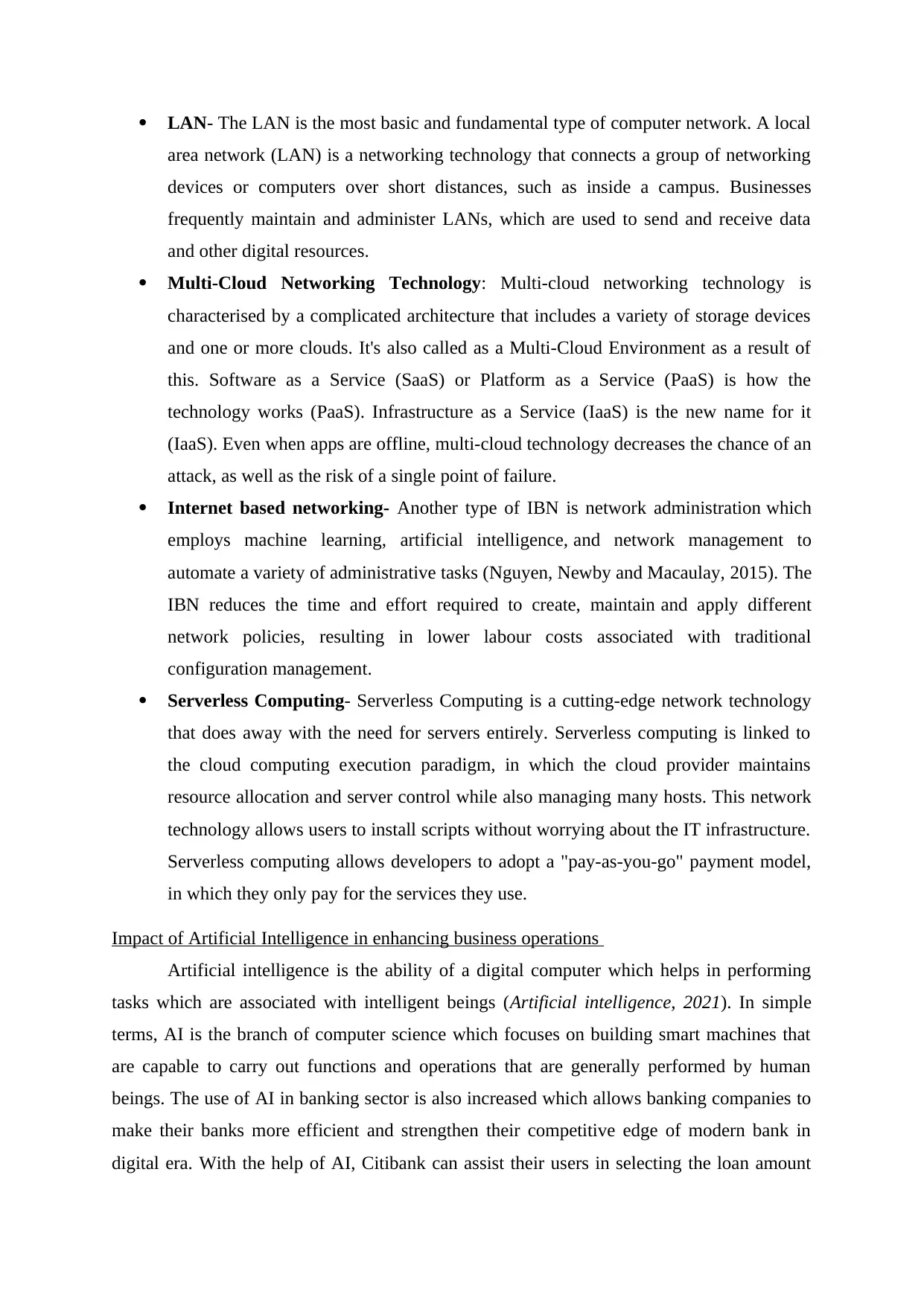
LAN- The LAN is the most basic and fundamental type of computer network. A local
area network (LAN) is a networking technology that connects a group of networking
devices or computers over short distances, such as inside a campus. Businesses
frequently maintain and administer LANs, which are used to send and receive data
and other digital resources.
Multi-Cloud Networking Technology: Multi-cloud networking technology is
characterised by a complicated architecture that includes a variety of storage devices
and one or more clouds. It's also called as a Multi-Cloud Environment as a result of
this. Software as a Service (SaaS) or Platform as a Service (PaaS) is how the
technology works (PaaS). Infrastructure as a Service (IaaS) is the new name for it
(IaaS). Even when apps are offline, multi-cloud technology decreases the chance of an
attack, as well as the risk of a single point of failure.
Internet based networking- Another type of IBN is network administration which
employs machine learning, artificial intelligence, and network management to
automate a variety of administrative tasks (Nguyen, Newby and Macaulay, 2015). The
IBN reduces the time and effort required to create, maintain and apply different
network policies, resulting in lower labour costs associated with traditional
configuration management.
Serverless Computing- Serverless Computing is a cutting-edge network technology
that does away with the need for servers entirely. Serverless computing is linked to
the cloud computing execution paradigm, in which the cloud provider maintains
resource allocation and server control while also managing many hosts. This network
technology allows users to install scripts without worrying about the IT infrastructure.
Serverless computing allows developers to adopt a "pay-as-you-go" payment model,
in which they only pay for the services they use.
Impact of Artificial Intelligence in enhancing business operations
Artificial intelligence is the ability of a digital computer which helps in performing
tasks which are associated with intelligent beings (Artificial intelligence, 2021). In simple
terms, AI is the branch of computer science which focuses on building smart machines that
are capable to carry out functions and operations that are generally performed by human
beings. The use of AI in banking sector is also increased which allows banking companies to
make their banks more efficient and strengthen their competitive edge of modern bank in
digital era. With the help of AI, Citibank can assist their users in selecting the loan amount
area network (LAN) is a networking technology that connects a group of networking
devices or computers over short distances, such as inside a campus. Businesses
frequently maintain and administer LANs, which are used to send and receive data
and other digital resources.
Multi-Cloud Networking Technology: Multi-cloud networking technology is
characterised by a complicated architecture that includes a variety of storage devices
and one or more clouds. It's also called as a Multi-Cloud Environment as a result of
this. Software as a Service (SaaS) or Platform as a Service (PaaS) is how the
technology works (PaaS). Infrastructure as a Service (IaaS) is the new name for it
(IaaS). Even when apps are offline, multi-cloud technology decreases the chance of an
attack, as well as the risk of a single point of failure.
Internet based networking- Another type of IBN is network administration which
employs machine learning, artificial intelligence, and network management to
automate a variety of administrative tasks (Nguyen, Newby and Macaulay, 2015). The
IBN reduces the time and effort required to create, maintain and apply different
network policies, resulting in lower labour costs associated with traditional
configuration management.
Serverless Computing- Serverless Computing is a cutting-edge network technology
that does away with the need for servers entirely. Serverless computing is linked to
the cloud computing execution paradigm, in which the cloud provider maintains
resource allocation and server control while also managing many hosts. This network
technology allows users to install scripts without worrying about the IT infrastructure.
Serverless computing allows developers to adopt a "pay-as-you-go" payment model,
in which they only pay for the services they use.
Impact of Artificial Intelligence in enhancing business operations
Artificial intelligence is the ability of a digital computer which helps in performing
tasks which are associated with intelligent beings (Artificial intelligence, 2021). In simple
terms, AI is the branch of computer science which focuses on building smart machines that
are capable to carry out functions and operations that are generally performed by human
beings. The use of AI in banking sector is also increased which allows banking companies to
make their banks more efficient and strengthen their competitive edge of modern bank in
digital era. With the help of AI, Citibank can assist their users in selecting the loan amount
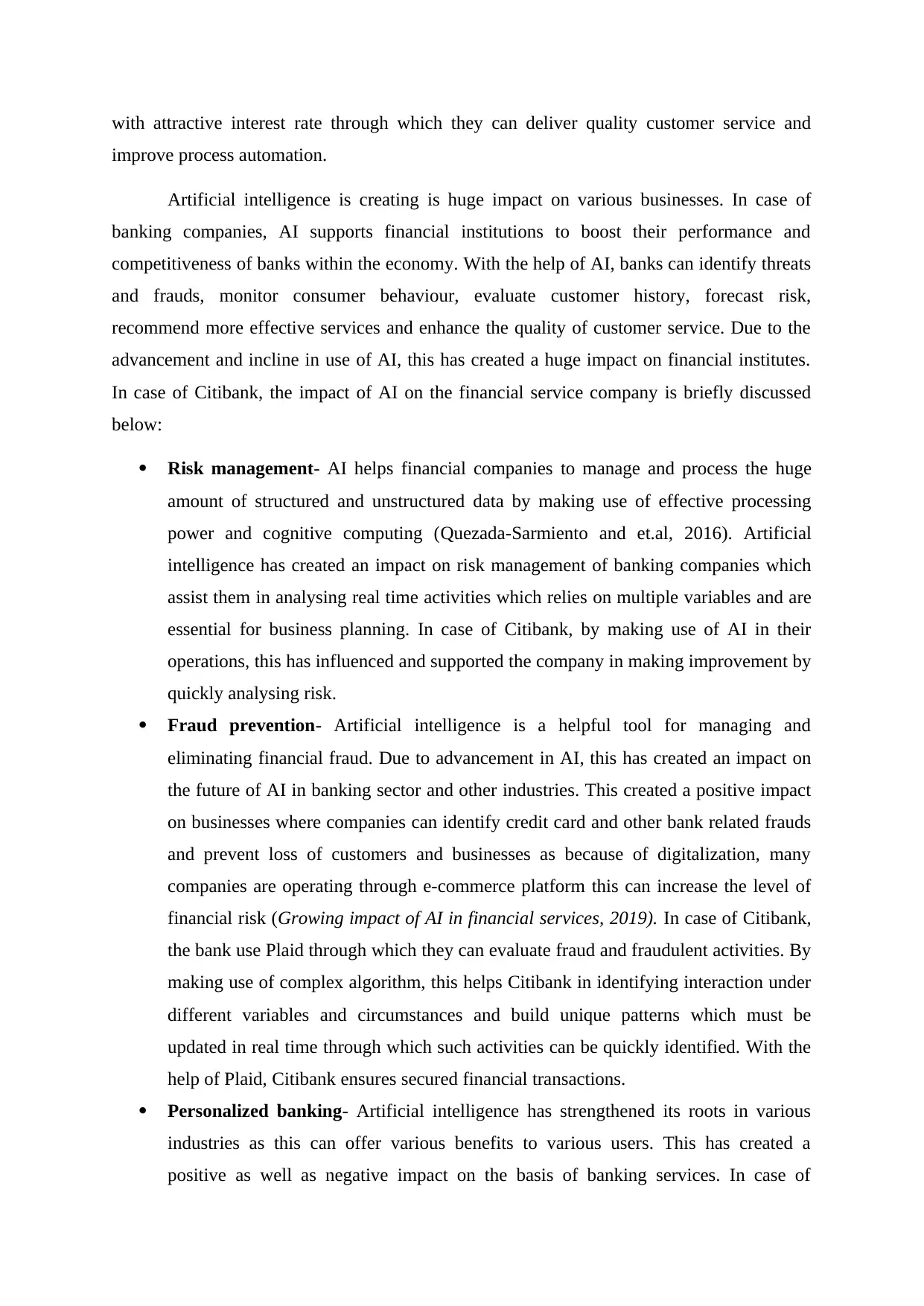
with attractive interest rate through which they can deliver quality customer service and
improve process automation.
Artificial intelligence is creating is huge impact on various businesses. In case of
banking companies, AI supports financial institutions to boost their performance and
competitiveness of banks within the economy. With the help of AI, banks can identify threats
and frauds, monitor consumer behaviour, evaluate customer history, forecast risk,
recommend more effective services and enhance the quality of customer service. Due to the
advancement and incline in use of AI, this has created a huge impact on financial institutes.
In case of Citibank, the impact of AI on the financial service company is briefly discussed
below:
Risk management- AI helps financial companies to manage and process the huge
amount of structured and unstructured data by making use of effective processing
power and cognitive computing (Quezada-Sarmiento and et.al, 2016). Artificial
intelligence has created an impact on risk management of banking companies which
assist them in analysing real time activities which relies on multiple variables and are
essential for business planning. In case of Citibank, by making use of AI in their
operations, this has influenced and supported the company in making improvement by
quickly analysing risk.
Fraud prevention- Artificial intelligence is a helpful tool for managing and
eliminating financial fraud. Due to advancement in AI, this has created an impact on
the future of AI in banking sector and other industries. This created a positive impact
on businesses where companies can identify credit card and other bank related frauds
and prevent loss of customers and businesses as because of digitalization, many
companies are operating through e-commerce platform this can increase the level of
financial risk (Growing impact of AI in financial services, 2019). In case of Citibank,
the bank use Plaid through which they can evaluate fraud and fraudulent activities. By
making use of complex algorithm, this helps Citibank in identifying interaction under
different variables and circumstances and build unique patterns which must be
updated in real time through which such activities can be quickly identified. With the
help of Plaid, Citibank ensures secured financial transactions.
Personalized banking- Artificial intelligence has strengthened its roots in various
industries as this can offer various benefits to various users. This has created a
positive as well as negative impact on the basis of banking services. In case of
improve process automation.
Artificial intelligence is creating is huge impact on various businesses. In case of
banking companies, AI supports financial institutions to boost their performance and
competitiveness of banks within the economy. With the help of AI, banks can identify threats
and frauds, monitor consumer behaviour, evaluate customer history, forecast risk,
recommend more effective services and enhance the quality of customer service. Due to the
advancement and incline in use of AI, this has created a huge impact on financial institutes.
In case of Citibank, the impact of AI on the financial service company is briefly discussed
below:
Risk management- AI helps financial companies to manage and process the huge
amount of structured and unstructured data by making use of effective processing
power and cognitive computing (Quezada-Sarmiento and et.al, 2016). Artificial
intelligence has created an impact on risk management of banking companies which
assist them in analysing real time activities which relies on multiple variables and are
essential for business planning. In case of Citibank, by making use of AI in their
operations, this has influenced and supported the company in making improvement by
quickly analysing risk.
Fraud prevention- Artificial intelligence is a helpful tool for managing and
eliminating financial fraud. Due to advancement in AI, this has created an impact on
the future of AI in banking sector and other industries. This created a positive impact
on businesses where companies can identify credit card and other bank related frauds
and prevent loss of customers and businesses as because of digitalization, many
companies are operating through e-commerce platform this can increase the level of
financial risk (Growing impact of AI in financial services, 2019). In case of Citibank,
the bank use Plaid through which they can evaluate fraud and fraudulent activities. By
making use of complex algorithm, this helps Citibank in identifying interaction under
different variables and circumstances and build unique patterns which must be
updated in real time through which such activities can be quickly identified. With the
help of Plaid, Citibank ensures secured financial transactions.
Personalized banking- Artificial intelligence has strengthened its roots in various
industries as this can offer various benefits to various users. This has created a
positive as well as negative impact on the basis of banking services. In case of
⊘ This is a preview!⊘
Do you want full access?
Subscribe today to unlock all pages.

Trusted by 1+ million students worldwide
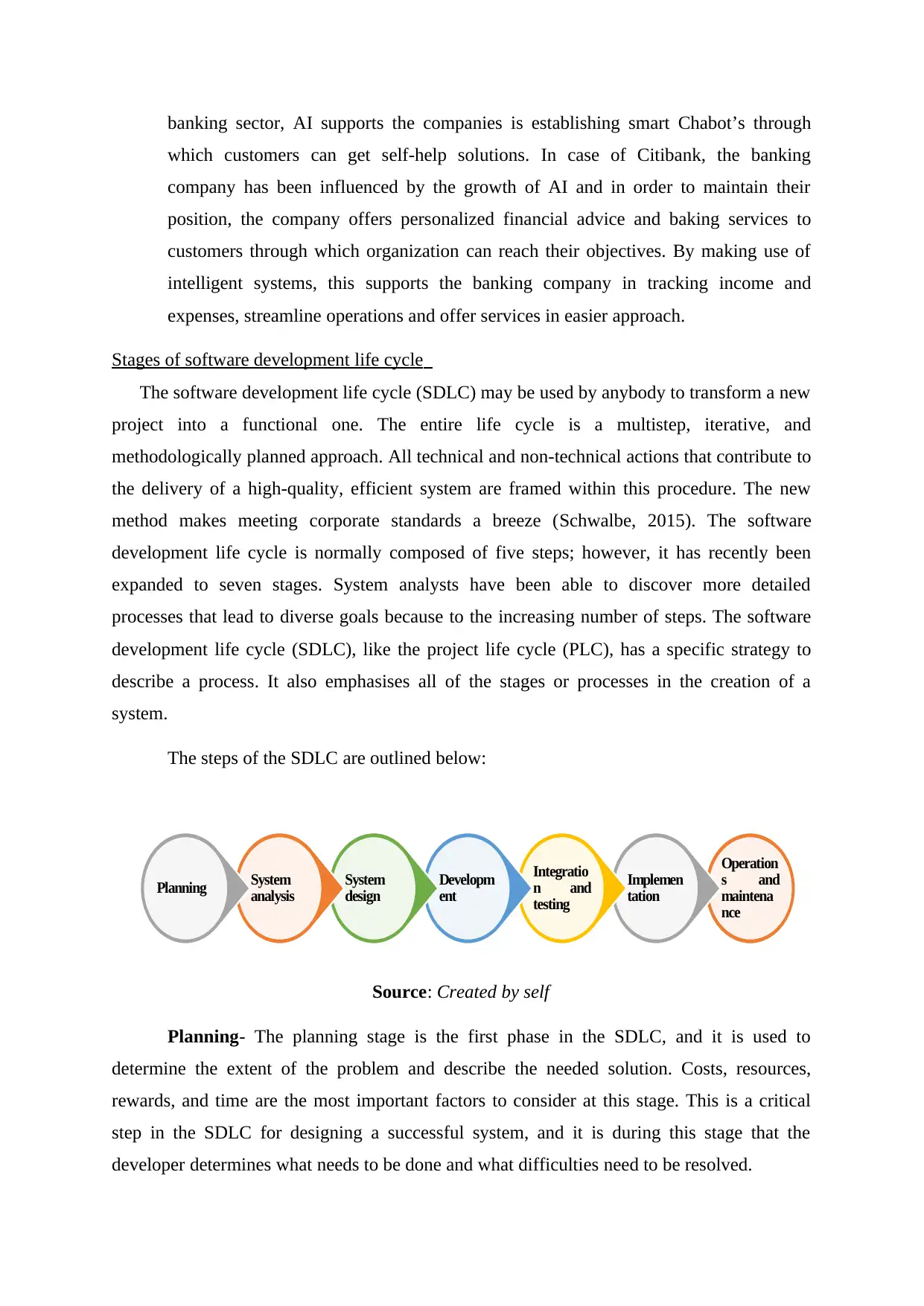
banking sector, AI supports the companies is establishing smart Chabot’s through
which customers can get self-help solutions. In case of Citibank, the banking
company has been influenced by the growth of AI and in order to maintain their
position, the company offers personalized financial advice and baking services to
customers through which organization can reach their objectives. By making use of
intelligent systems, this supports the banking company in tracking income and
expenses, streamline operations and offer services in easier approach.
Stages of software development life cycle
The software development life cycle (SDLC) may be used by anybody to transform a new
project into a functional one. The entire life cycle is a multistep, iterative, and
methodologically planned approach. All technical and non-technical actions that contribute to
the delivery of a high-quality, efficient system are framed within this procedure. The new
method makes meeting corporate standards a breeze (Schwalbe, 2015). The software
development life cycle is normally composed of five steps; however, it has recently been
expanded to seven stages. System analysts have been able to discover more detailed
processes that lead to diverse goals because to the increasing number of steps. The software
development life cycle (SDLC), like the project life cycle (PLC), has a specific strategy to
describe a process. It also emphasises all of the stages or processes in the creation of a
system.
The steps of the SDLC are outlined below:
Source: Created by self
Planning- The planning stage is the first phase in the SDLC, and it is used to
determine the extent of the problem and describe the needed solution. Costs, resources,
rewards, and time are the most important factors to consider at this stage. This is a critical
step in the SDLC for designing a successful system, and it is during this stage that the
developer determines what needs to be done and what difficulties need to be resolved.
Operation
s and
maintena
nce
Implemen
tation
Integratio
n and
testing
Developm
ent
System
design
System
analysis
Planning
which customers can get self-help solutions. In case of Citibank, the banking
company has been influenced by the growth of AI and in order to maintain their
position, the company offers personalized financial advice and baking services to
customers through which organization can reach their objectives. By making use of
intelligent systems, this supports the banking company in tracking income and
expenses, streamline operations and offer services in easier approach.
Stages of software development life cycle
The software development life cycle (SDLC) may be used by anybody to transform a new
project into a functional one. The entire life cycle is a multistep, iterative, and
methodologically planned approach. All technical and non-technical actions that contribute to
the delivery of a high-quality, efficient system are framed within this procedure. The new
method makes meeting corporate standards a breeze (Schwalbe, 2015). The software
development life cycle is normally composed of five steps; however, it has recently been
expanded to seven stages. System analysts have been able to discover more detailed
processes that lead to diverse goals because to the increasing number of steps. The software
development life cycle (SDLC), like the project life cycle (PLC), has a specific strategy to
describe a process. It also emphasises all of the stages or processes in the creation of a
system.
The steps of the SDLC are outlined below:
Source: Created by self
Planning- The planning stage is the first phase in the SDLC, and it is used to
determine the extent of the problem and describe the needed solution. Costs, resources,
rewards, and time are the most important factors to consider at this stage. This is a critical
step in the SDLC for designing a successful system, and it is during this stage that the
developer determines what needs to be done and what difficulties need to be resolved.
Operation
s and
maintena
nce
Implemen
tation
Integratio
n and
testing
Developm
ent
System
design
System
analysis
Planning
Paraphrase This Document
Need a fresh take? Get an instant paraphrase of this document with our AI Paraphraser
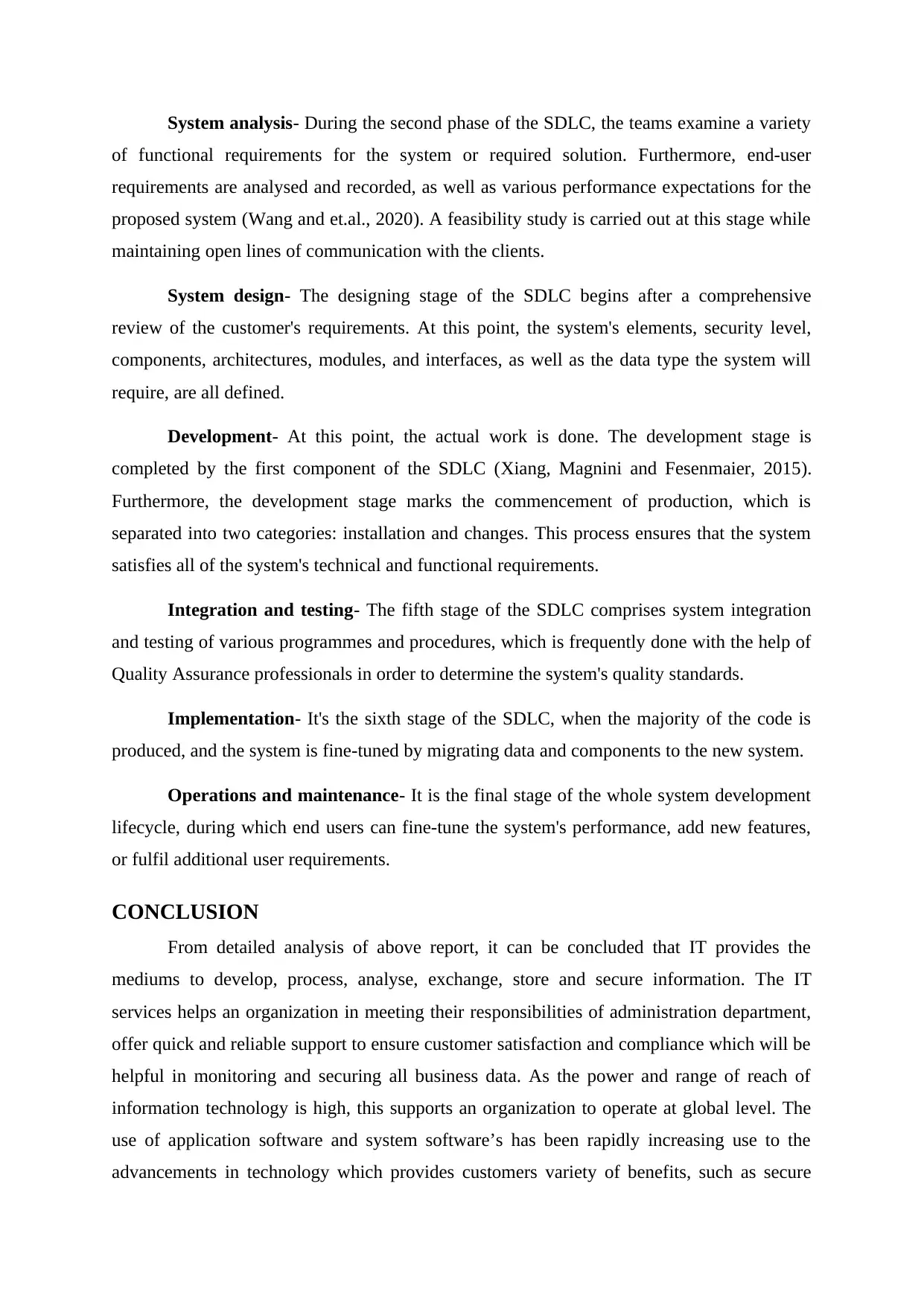
System analysis- During the second phase of the SDLC, the teams examine a variety
of functional requirements for the system or required solution. Furthermore, end-user
requirements are analysed and recorded, as well as various performance expectations for the
proposed system (Wang and et.al., 2020). A feasibility study is carried out at this stage while
maintaining open lines of communication with the clients.
System design- The designing stage of the SDLC begins after a comprehensive
review of the customer's requirements. At this point, the system's elements, security level,
components, architectures, modules, and interfaces, as well as the data type the system will
require, are all defined.
Development- At this point, the actual work is done. The development stage is
completed by the first component of the SDLC (Xiang, Magnini and Fesenmaier, 2015).
Furthermore, the development stage marks the commencement of production, which is
separated into two categories: installation and changes. This process ensures that the system
satisfies all of the system's technical and functional requirements.
Integration and testing- The fifth stage of the SDLC comprises system integration
and testing of various programmes and procedures, which is frequently done with the help of
Quality Assurance professionals in order to determine the system's quality standards.
Implementation- It's the sixth stage of the SDLC, when the majority of the code is
produced, and the system is fine-tuned by migrating data and components to the new system.
Operations and maintenance- It is the final stage of the whole system development
lifecycle, during which end users can fine-tune the system's performance, add new features,
or fulfil additional user requirements.
CONCLUSION
From detailed analysis of above report, it can be concluded that IT provides the
mediums to develop, process, analyse, exchange, store and secure information. The IT
services helps an organization in meeting their responsibilities of administration department,
offer quick and reliable support to ensure customer satisfaction and compliance which will be
helpful in monitoring and securing all business data. As the power and range of reach of
information technology is high, this supports an organization to operate at global level. The
use of application software and system software’s has been rapidly increasing use to the
advancements in technology which provides customers variety of benefits, such as secure
of functional requirements for the system or required solution. Furthermore, end-user
requirements are analysed and recorded, as well as various performance expectations for the
proposed system (Wang and et.al., 2020). A feasibility study is carried out at this stage while
maintaining open lines of communication with the clients.
System design- The designing stage of the SDLC begins after a comprehensive
review of the customer's requirements. At this point, the system's elements, security level,
components, architectures, modules, and interfaces, as well as the data type the system will
require, are all defined.
Development- At this point, the actual work is done. The development stage is
completed by the first component of the SDLC (Xiang, Magnini and Fesenmaier, 2015).
Furthermore, the development stage marks the commencement of production, which is
separated into two categories: installation and changes. This process ensures that the system
satisfies all of the system's technical and functional requirements.
Integration and testing- The fifth stage of the SDLC comprises system integration
and testing of various programmes and procedures, which is frequently done with the help of
Quality Assurance professionals in order to determine the system's quality standards.
Implementation- It's the sixth stage of the SDLC, when the majority of the code is
produced, and the system is fine-tuned by migrating data and components to the new system.
Operations and maintenance- It is the final stage of the whole system development
lifecycle, during which end users can fine-tune the system's performance, add new features,
or fulfil additional user requirements.
CONCLUSION
From detailed analysis of above report, it can be concluded that IT provides the
mediums to develop, process, analyse, exchange, store and secure information. The IT
services helps an organization in meeting their responsibilities of administration department,
offer quick and reliable support to ensure customer satisfaction and compliance which will be
helpful in monitoring and securing all business data. As the power and range of reach of
information technology is high, this supports an organization to operate at global level. The
use of application software and system software’s has been rapidly increasing use to the
advancements in technology which provides customers variety of benefits, such as secure
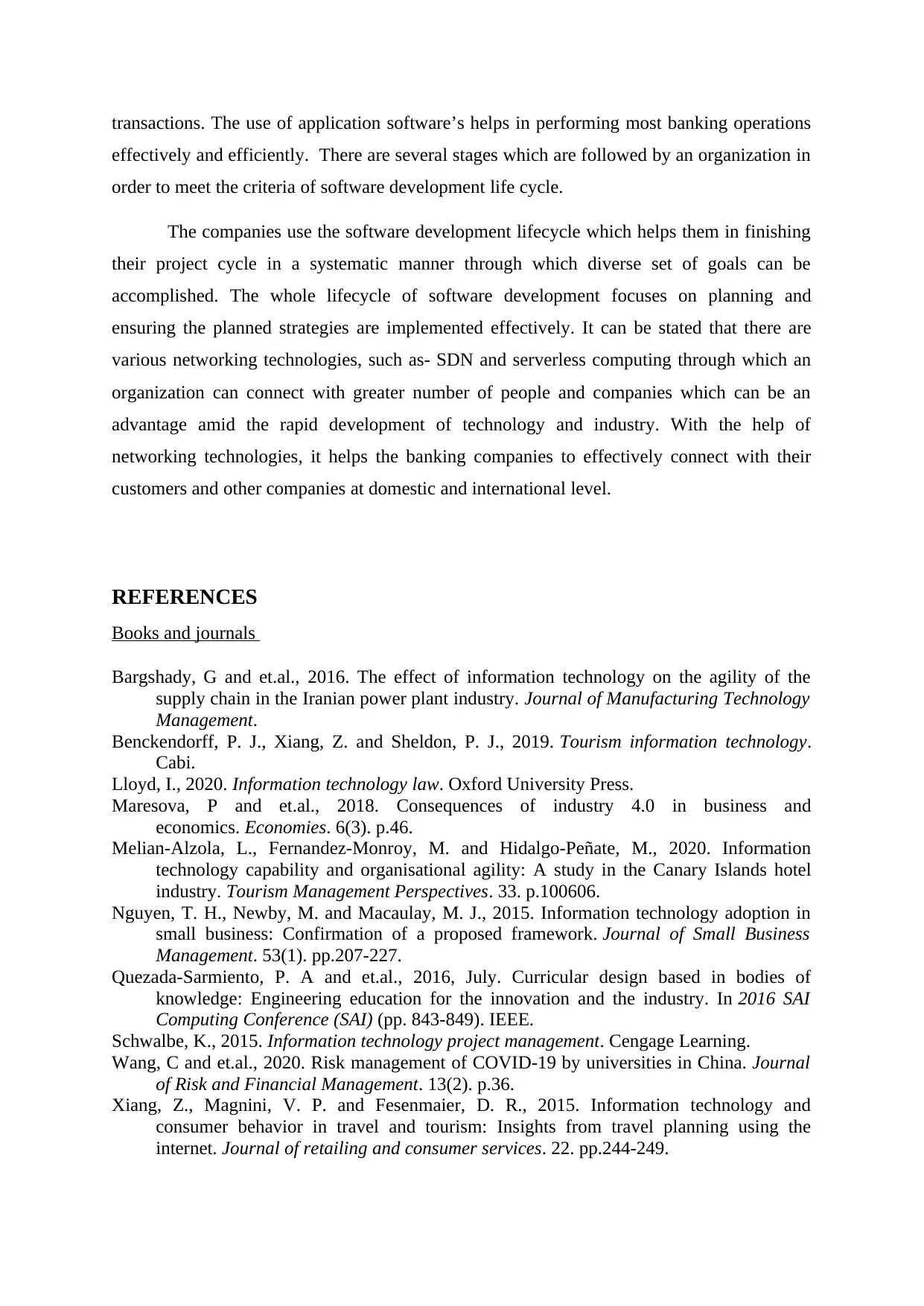
transactions. The use of application software’s helps in performing most banking operations
effectively and efficiently. There are several stages which are followed by an organization in
order to meet the criteria of software development life cycle.
The companies use the software development lifecycle which helps them in finishing
their project cycle in a systematic manner through which diverse set of goals can be
accomplished. The whole lifecycle of software development focuses on planning and
ensuring the planned strategies are implemented effectively. It can be stated that there are
various networking technologies, such as- SDN and serverless computing through which an
organization can connect with greater number of people and companies which can be an
advantage amid the rapid development of technology and industry. With the help of
networking technologies, it helps the banking companies to effectively connect with their
customers and other companies at domestic and international level.
REFERENCES
Books and journals
Bargshady, G and et.al., 2016. The effect of information technology on the agility of the
supply chain in the Iranian power plant industry. Journal of Manufacturing Technology
Management.
Benckendorff, P. J., Xiang, Z. and Sheldon, P. J., 2019. Tourism information technology.
Cabi.
Lloyd, I., 2020. Information technology law. Oxford University Press.
Maresova, P and et.al., 2018. Consequences of industry 4.0 in business and
economics. Economies. 6(3). p.46.
Melian-Alzola, L., Fernandez-Monroy, M. and Hidalgo-Peñate, M., 2020. Information
technology capability and organisational agility: A study in the Canary Islands hotel
industry. Tourism Management Perspectives. 33. p.100606.
Nguyen, T. H., Newby, M. and Macaulay, M. J., 2015. Information technology adoption in
small business: Confirmation of a proposed framework. Journal of Small Business
Management. 53(1). pp.207-227.
Quezada-Sarmiento, P. A and et.al., 2016, July. Curricular design based in bodies of
knowledge: Engineering education for the innovation and the industry. In 2016 SAI
Computing Conference (SAI) (pp. 843-849). IEEE.
Schwalbe, K., 2015. Information technology project management. Cengage Learning.
Wang, C and et.al., 2020. Risk management of COVID-19 by universities in China. Journal
of Risk and Financial Management. 13(2). p.36.
Xiang, Z., Magnini, V. P. and Fesenmaier, D. R., 2015. Information technology and
consumer behavior in travel and tourism: Insights from travel planning using the
internet. Journal of retailing and consumer services. 22. pp.244-249.
effectively and efficiently. There are several stages which are followed by an organization in
order to meet the criteria of software development life cycle.
The companies use the software development lifecycle which helps them in finishing
their project cycle in a systematic manner through which diverse set of goals can be
accomplished. The whole lifecycle of software development focuses on planning and
ensuring the planned strategies are implemented effectively. It can be stated that there are
various networking technologies, such as- SDN and serverless computing through which an
organization can connect with greater number of people and companies which can be an
advantage amid the rapid development of technology and industry. With the help of
networking technologies, it helps the banking companies to effectively connect with their
customers and other companies at domestic and international level.
REFERENCES
Books and journals
Bargshady, G and et.al., 2016. The effect of information technology on the agility of the
supply chain in the Iranian power plant industry. Journal of Manufacturing Technology
Management.
Benckendorff, P. J., Xiang, Z. and Sheldon, P. J., 2019. Tourism information technology.
Cabi.
Lloyd, I., 2020. Information technology law. Oxford University Press.
Maresova, P and et.al., 2018. Consequences of industry 4.0 in business and
economics. Economies. 6(3). p.46.
Melian-Alzola, L., Fernandez-Monroy, M. and Hidalgo-Peñate, M., 2020. Information
technology capability and organisational agility: A study in the Canary Islands hotel
industry. Tourism Management Perspectives. 33. p.100606.
Nguyen, T. H., Newby, M. and Macaulay, M. J., 2015. Information technology adoption in
small business: Confirmation of a proposed framework. Journal of Small Business
Management. 53(1). pp.207-227.
Quezada-Sarmiento, P. A and et.al., 2016, July. Curricular design based in bodies of
knowledge: Engineering education for the innovation and the industry. In 2016 SAI
Computing Conference (SAI) (pp. 843-849). IEEE.
Schwalbe, K., 2015. Information technology project management. Cengage Learning.
Wang, C and et.al., 2020. Risk management of COVID-19 by universities in China. Journal
of Risk and Financial Management. 13(2). p.36.
Xiang, Z., Magnini, V. P. and Fesenmaier, D. R., 2015. Information technology and
consumer behavior in travel and tourism: Insights from travel planning using the
internet. Journal of retailing and consumer services. 22. pp.244-249.
⊘ This is a preview!⊘
Do you want full access?
Subscribe today to unlock all pages.

Trusted by 1+ million students worldwide
1 out of 13
Related Documents
Your All-in-One AI-Powered Toolkit for Academic Success.
+13062052269
info@desklib.com
Available 24*7 on WhatsApp / Email
![[object Object]](/_next/static/media/star-bottom.7253800d.svg)
Unlock your academic potential
Copyright © 2020–2025 A2Z Services. All Rights Reserved. Developed and managed by ZUCOL.


